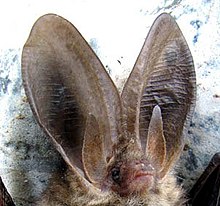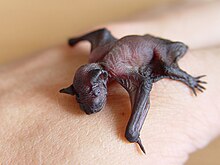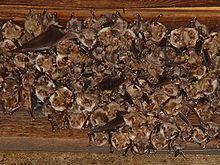From Wikipedia, the free encyclopedia
| Bat Temporal range: Eocene – Present | |
|---|---|
 | |
| Worldwide distribution of bat species |
Bats are mammals of the order Chiroptera ... whose forelimbs form webbed wings, making them the only mammals naturally capable of true and sustained flight. By contrast, other mammals said to fly, such as flying squirrels, gliding possums, and colugos, can only glide for short distances. Bats are less efficient at flying than birds, but are more manoeuvrable, using their very long spread-out digits which are covered with a thin membrane or patagium.
Bats are the second largest order of mammals (after the rodents), representing about 20% of all classified mammal species worldwide, with about 1,240 bat species divided into two suborders: the less specialized and largely fruit-eating megabats, or flying foxes, and the highly specialized and echolocating microbats. About 70% of bat species are insectivores. Most of the rest are frugivores, or fruit eaters. A few species, such as the fish-eating bat, feed from animals other than insects, with the vampire bats being hematophagous, or feeding on blood.
Bats are present throughout most of the world, with the exception of extremely cold regions. They perform the vital ecological roles of pollinating flowers and dispersing fruit seeds; many tropical plant species depend entirely on bats for the distribution of their seeds. Bats are economically important, as they consume insect pests, reducing the need for pesticides. The smallest bat is the Kitti's hog-nosed bat,...It is also arguably the smallest extant species of mammal, with the Etruscan shrew being the other contender. The largest species of bat are a few species of Pteropus (fruit bats or flying foxes) and the giant golden-crowned flying fox...
The Mexican free-tailed bat is the fastest flying animal in horizontal flight.
An older English name for bats is flittermouse, which matches their name in other Germanic languages (for example German Fledermaus and Swedish fladdermus), related to fluttering of wings.
...
Habitats
Flight has enabled bats to become one of the most widely distributed groups of mammals. Apart from the Arctic, the Antarctic and a few isolated oceanic islands, bats exist all over the world. Bats are found in almost every habitat available on Earth. Different species select different habitats during different seasons, ranging from seasides to mountains and even deserts, but bat habitats have two basic requirements: roosts, where they spend the day or hibernate, and places for foraging. Most temperate species additionally need a relatively warm hibernation shelter. Bat roosts can be found in hollows, crevices, foliage, and even human-made structures, and include "tents" the bats construct by biting leaves.
The United States is home to an estimated 45 to 48 species of bats. The three most common species are Myotis lucifugus(little brown bat), Eptesicus fuscus (big brown bat), and Tadarida brasiliensis (Mexican free-tailed bat). The little and the big brown bats are common throughout the northern two-thirds of the country, while the Mexican free-tailed bat is the most common species in the southwest, sometimes even appearing in portions of the Southeast.
...
The teeth of microbats resemble insectivorans. They are very sharp to bite through the hardened armor of insects or the skin of fruit.
The tube-lipped nectar bat (Anoura fistulata) has the longest tongue of any mammal relative to its body size. This is beneficial to them in terms of pollination and feeding. Their long, narrow tongues can reach deep into the long cup shape of some flowers. When the tongue retracts, it coils up inside its rib cage.
Bats possess highly adapted lung systems to cope with the pressures of powered-flight. Flight is an energetically taxing aerobic activity and requires large amounts of oxygen to be sustained. In bats, the relative alveolar surface area and pulmonary capillary blood volume are significantly larger than most other small quadrupedal mammals.
Echolocation
Bat echolocation is a perceptual system where ultrasonic sounds are emitted specifically to produce echoes. By comparing the outgoing pulse with the returning echoes, the brain and auditory nervous system can produce detailed images of the bat's surroundings. This allows bats to detect, localize, and even classify their prey in complete darkness. At 130 decibels in intensity, bat calls are some of the most intense, airborne animal sounds.[59]
To clearly distinguish returning information, bats must be able to separate their calls from the echoes that they receive. Microbats use two distinct approaches.
- Low duty cycle echolocation: Bats can separate their calls and returning echoes by time. Bats that use this approach time their short calls to finish before echoes return. This is important because these bats contract their middle ear muscles when emitting a call, so they can avoid deafening themselves. The time interval between the call and echo allows them to relax these muscles, so they can clearly hear the returning echo.The delay of the returning echoes provides the bat with the ability to estimate the range to their prey.
- High duty cycle echolocation: Bats emit a continuous call and separate pulse and echo in frequency. The ears of these bats are sharply tuned to a specific frequency range. They emit calls outside of this range to avoid self-deafening. They then receive echoes back at the finely tuned frequency range by taking advantage of the Doppler shift of their motion in flight. The Doppler shift of the returning echoes yields information relating to the motion and location of the bat's prey. These bats must deal with changes in the Doppler shift due to changes in their flight speed. They have adapted to change their pulse emission frequency in relation to their flight speed so echoes still return in the optimal hearing range.
...
Two groups of moths exploit a bat sense to echolocate: tiger moths produce ultrasonic signals to warn the bats that they (the moths) are chemically protected or aposematic, other moth species produce signals to jam bat echolocation. Many moth species have a hearing organ called a tympanum, which responds to an incoming bat signal by causing the moth's flight muscles to twitch erratically, sending the moth into random evasive maneuvers.
In addition to echolocating prey, bat ears are sensitive to the fluttering of moth wings, the sounds produced by tymbalate insects, and the movement of ground-dwelling prey, such as centipedes, earwigs, etc. The complex geometry of ridges on the inner surface of bat ears helps to sharply focus not only echolocation signals, but also to passively listen for any other sound produced by the prey. These ridges can be regarded as the acoustic equivalent of a Fresnel lens, and may be seen in a large variety of unrelated animals, such as the aye-aye, lesser galago, bat-eared fox, mouse lemur, and others.
By repeated scanning, bats can mentally construct an accurate image of the environment in which they are moving and of their prey item.[66]
Other senses
Although the eyes of most microbat species are small and poorly developed, leading to poor visual acuity, no species is blind. Microbats use vision to navigate, especially for long distances when beyond the range of echolocation, and species that are gleaners—that is, ones that attempt to swoop down from above to ambush insects, like crickets on the ground or moths up a tree, often have eyesight about as good as a rat's. Some species have been shown to be able to detect ultraviolet light, and most cave-dwelling species have developed the ability to utilize very dim light. They also have high-quality senses of smell and hearing. Bats hunt at night, reducing competition with birds, minimizing contact with certain predators, and travel large distances (up to 800 km) in their search for food.
Megabat species often have excellent eyesight as good as, if not better than, human vision. This eyesight is, unlike that of its microbat relatives, adapted to both night and daylight vision and enables the bat to have some colour vision whereas the microbat sees in blurred shades of grey.
Behaviour
Most microbats are nocturnal and are active at twilight. A large portion of bats migrate hundreds of kilometres to winter hibernation dens, while some pass into torpor in cold weather, rousing and feeding when warm weather allows for insects to be active. Others retreat to caves for winter and hibernate for six months. Bats rarely fly in rain, as the rain interferes with their echolocation, and they are unable to locate their food.
The social structure of bats varies, with some leading solitary lives and others living in caves colonized by more than a million bats. The fission-fusion social structure is seen among several species of bats. The term "fusion" refers to a large numbers of bats that congregate in one roosting area, and "fission" refers to breaking up and the mixing of subgroups, with individual bats switching roosts with others and often ending up in different trees and with different roost mates.
Studies also show that bats make various sounds in order to communicate with one another. Scientists in the field have listened to bats and have been able to associate certain sounds with certain behaviours that bats make after the sounds are made.
Insectivores make up 70% of bat species and locate their prey by means of echolocation. Of the remainder, most feed on fruits. Only three species sustain themselves with blood.
Some species even prey on vertebrates. The leaf-nosed bats (Phyllostomidae) of Central America and South America, and the two bulldog bat (Noctilionidae) species feed on fish. At least two species of bat are known to feed on other bats: the spectral bat, also known as the American false vampire bat, and the ghost bat of Australia.[ One species, the greater noctule bat, catches and eats small birds in the air.
Predators
Reproduction
Most bats have a breeding season, which is in the spring for species living in a temperate climate. Bats may have one to three litters in a season, depending on the species and on environmental conditions, such as the availability of food and roost sites. Females generally have one offspring at a time, which could be a result of the mother's need to fly to feed while pregnant. Female bats nurse their young until they are nearly adult size, because a young bat cannot forage on its own until its wings are fully developed.
Female bats use a variety of strategies to control the timing of pregnancy and the birth of young, to make delivery coincide with maximum food ability and other ecological factors. Females of some species have delayed fertilization, in which sperm is stored in the reproductive tract for several months after mating. In many such cases, mating occurs in the fall, and fertilization does not occur until the following spring. Other species exhibit delayed implantation, in which the egg is fertilized after mating, but remains free in the reproductive tract until external conditions become favorable for giving birth and caring for the offspring.
In yet another strategy, fertilization and implantation both occur, but development of the fetus is delayed until favorable conditions prevail, during the delayed development the mother still gives the fertilized egg nutrients, and oxygenated blood to keep it alive. However, this process can go for a long period of time, because of the advanced gas exchange system. All of these adaptations result in the pup being born during a time of high local production of fruit or insects.
At birth, the wings are too small to be used for flight. Young microbats become independent at the age of six to eight weeks, while megabats do not until they are four months old.
Life expectancy
A single bat can live over 20 years, but bat population growth is limited by the slow birth rate. Five species have been recorded living over 30 years in the wild: the brown long-eared bat (Plecotus auritus), little brown bat (Myotis lucifugus), Brandt's bat (Myotis brandti), lesser mouse-eared bat (Myotis blythii) and greater horseshoe bat (Rhinolophus ferrumequinum).
Hunting, feeding, and drinking
Newborn bats feed solely on their mother's milk. When they are a few weeks old, bats are expected to fly and hunt on their own. It is up to them to find and catch their prey, along with satisfying their thirst.
To survive hibernation months, some species build up large reserves of body fat, both as fuel and as insulation.










No comments:
Post a Comment